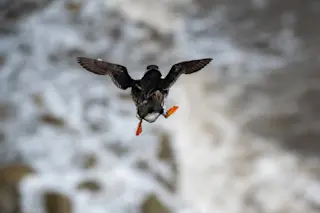You may have seen photos and videos circling the internet of people throwing baby puffins, or pufflings, off of cliffs. While you may have been shocked, it’s actually a common practice in Iceland. Once pufflings are ready to venture off on their own, they should make their way out to sea and join their flock. However, some of them can get stuck, so the communities around Iceland come together to help pufflings find their way home. This is called puffling season.
Puffins are sea birds in the Alcidae (Auk) family. Though their beak and black and white feathers look similar to a penguin, they are not closely related. Their close relatives include the guillemot and the razorbill. Puffins, along with other Auks, can fly, unlike penguins.
(Credit:DWeeks/Shutterstock)
There are four species of puffin: the Atlantic, the horned, the tufted and the rhinoceros auklet. The Atlantic is the most common, found ...















